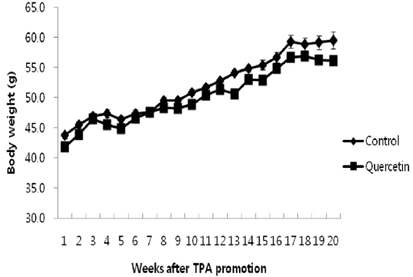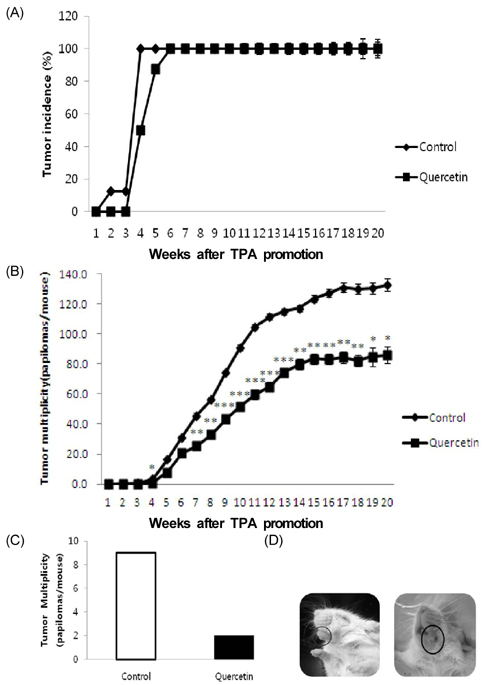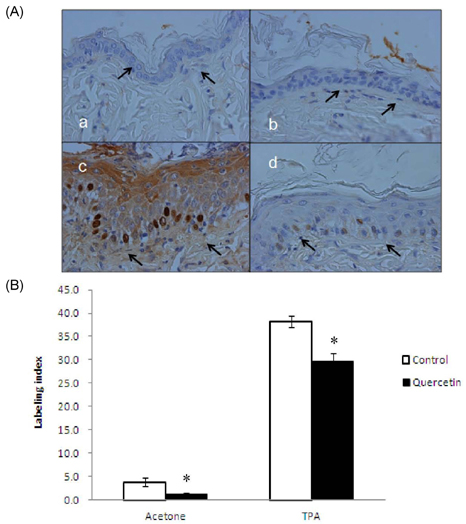Nutr Res Pract.
2013 Dec;7(6):439-445.
Anticarcinogenic effect of quercetin by inhibition of insulin-like growth factor (IGF)-1 signaling in mouse skin cancer
- Affiliations
-
- 1Department of Food Science and Nutrition, Kyungpook National University, Daegu 702-701, Korea.
- 2Department of Food and Nutrition, Daegu University, Gyeongbuk 712-714, Korea.
- 3Department of Food Science and Nutrition, Catholic University of Daegu, 13-13 Hayangro, Hayangeup, Gyeongsan, Gyeongbuk 712-702, Korea. kimeunj@cu.ac.kr
Abstract
- It has been shown that dysregulation of IGF-1 signaling is associated with tumor incidence and progression, whereas blockade of the signaling can effectively inhibit carcinogenesis. Although several mechanisms of anticancer activity of quercetin were proposed, molecular targets of quercetin have not been identified yet. Hence, we assessed the effect of quercetin on IGF-1 signaling inhibition in BK5.IGF-1 transgenic (Tg) mice, which over-expresses IGF-1 in the skin epidermis. A quercetin diet (0.02% wt/wt) for 20 weeks remarkably delayed the incidence of skin tumor by 2 weeks and reduced tumor multiplicity by 35% in a 7,12-dimethylbenz(a)anthracene (DMBA)-tetradecanoyl phorbol-13-acetate (TPA) two stage mouse skin carcinogenesis protocol. Moreover, skin hyperplasia in Tg mice was significantly inhibited by a quercetin supplementation. Further analysis of the MT1/2 skin papilloma cell line showed that a quercetin treatment dose dependently suppressed IGF-1 induced phosphorylation of the IGF-1 receptor (IGF-1R), insulin receptor substrate (IRS)-1, Akt and S6K; however, had no effect on the phosphorylation of PTEN. Additionally, the quercetin treatment inhibited IGF-1 stimulated cell proliferation in a dose dependent manner. Taken together, these data suggest that quercetin has a potent anticancer activity through the inhibition of IGF-1 signaling.
Keyword
MeSH Terms
-
Animals
Anticarcinogenic Agents*
Cell Line
Cell Proliferation
Diet
Epidermis
Hyperplasia
Incidence
Insulin-Like Growth Factor I
Mice*
Papilloma
Phosphorylation
Quercetin*
Receptor, IGF Type 1
Receptor, Insulin
Skin Neoplasms*
Skin*
Anticarcinogenic Agents
Insulin-Like Growth Factor I
Quercetin
Receptor, IGF Type 1
Receptor, Insulin
Figure
Reference
-
1. Kim E, Goraksha-Hicks P, Li L, Neufeld TP, Guan KL. Regulation of TORC1 by Rag GTPases in nutrient response. Nat Cell Biol. 2008; 10:935–945.
Article2. Harrington LS, Findlay GM, Gray A, Tolkacheva T, Wigfield S, Rebholz H, Barnett J, Leslie NR, Cheng S, Shepherd PR, Gout I, Downes CP, Lamb RF. The TSC1-2 tumor suppressor controls insulin-PI3K signaling via regulation of IRS proteins. J Cell Biol. 2004; 166:213–223.
Article3. Remacle-Bonnet MM, Garrouste FL, Heller S, André F, Marvaldi JL, Pommier GJ. Insulin-like growth factor-I protects colon cancer cells from death factor-induced apoptosis by potentiating tumor necrosis factor alpha-induced mitogen-activated protein kinase and nuclear factor kappaB signaling pathways. Cancer Res. 2000; 60:2007–2017.4. Shah OJ, Wang Z, Hunter T. Inappropriate activation of the TSC/Rheb/mTOR/S6K cassette induces IRS1/2 depletion, insulin resistance, and cell survival deficiencies. Curr Biol. 2004; 14:1650–1656.
Article5. DiGiovanni J, Bol DK, Wilker E, Beltrán L, Carbajal S, Moats S, Ramirez A, Jorcano J, Kiguchi K. Constitutive expression of insulin-like growth factor-1 in epidermal basal cells of transgenic mice leads to spontaneous tumor promotion. Cancer Res. 2000; 60:1561–1570.6. Serafini M, Bellocco R, Wolk A, Ekström AM. Total antioxidant potential of fruit and vegetables and risk of gastric cancer. Gastroenterology. 2002; 123:985–991.
Article7. Kyle JA, Sharp L, Little J, Duthie GG, McNeill G. Dietary flavonoid intake and colorectal cancer: a case-control study. Br J Nutr. 2010; 103:429–436.
Article8. Neuhouser ML. Dietary flavonoids and cancer risk: evidence from human population studies. Nutr Cancer. 2004; 50:1–7.
Article9. Duthie SJ, Dobson VL. Dietary flavonoids protect human colonocyte DNA from oxidative attack in vitro. Eur J Nutr. 1999; 38:28–34.
Article10. Granado-Serrano AB, Martín MA, Bravo L, Goya L, Ramos S. Quercetin induces apoptosis via caspase activation, regulation of Bcl-2, and inhibition of PI-3-kinase/Akt and ERK pathways in a human hepatoma cell line (HepG2). J Nutr. 2006; 136:2715–2721.
Article11. Phan TT, See P, Tran E, Nguyen TT, Chan SY, Lee ST, Huynh H. Suppression of insulin-like growth factor signalling pathway and collagen expression in keloid-derived fibroblasts by quercetin: its therapeutic potential use in the treatment and/or prevention of keloids. Br J Dermatol. 2003; 148:544–552.
Article12. Vijayababu MR, Kanagaraj P, Arunkumar A, Ilangovan R, Aruldhas MM, Arunakaran J. Quercetin-induced growth inhibition and cell death in prostatic carcinoma cells (PC-3) are associated with increase in p21 and hypophosphorylated retinoblastoma proteins expression. J Cancer Res Clin Oncol. 2005; 131:765–771.
Article13. Senthilkumar K, Elumalai P, Arunkumar R, Banudevi S, Gunadharini ND, Sharmila G, Selvakumar K, Arunakaran J. Quercetin regulates insulin like growth factor signaling and induces intrinsic and extrinsic pathway mediated apoptosis in androgen independent prostate cancer cells (PC-3). Mol Cell Biochem. 2010; 344:173–184.
Article14. Giuliani C, Noguchi Y, Harii N, Napolitano G, Tatone D, Bucci I, Piantelli M, Monaco F, Kohn LD. The flavonoid quercetin regulates growth and gene expression in rat FRTL-5 thyroid cells. Endocrinology. 2008; 149:84–92.
Article15. Murphy EA, Davis JM, McClellan JL, Carmichael MD. Quercetin's effects on intestinal polyp multiplicity and macrophage number in the Apc (Min/+) mouse. Nutr Cancer. 2011; 63:421–426.
Article16. Conti CJ, Fries JW, Viaje A, Miller DR, Morris R, Slaga TJ. In vivo behavior of murine epidermal cell lines derived from initiated and noninitiated skin. Cancer Res. 1988; 48:435–439.17. Satyamoorthy K, Li G, Vaidya B, Patel D, Herlyn M. Insulin-like growth factor-1 induces survival and growth of biologically early melanoma cells through both the mitogen-activated protein kinase and beta-catenin pathways. Cancer Res. 2001; 61:7318–7324.18. Takeuchi K, Ito F. Receptor tyrosine kinases and targeted cancer therapeutics. Biol Pharm Bull. 2011; 34:1774–1780.
Article19. Gallagher EJ, LeRoith D. Minireview: IGF, insulin, and cancer. Endocrinology. 2011; 152:2546–2551.
Article20. Vasanthi HR, Mukherjee S, Das DK. Potential health benefits of broccoli- a chemico-biological overview. Mini Rev Med Chem. 2009; 9:749–759.
Article21. Slimestad R, Fossen T, Vågen IM. Onions: a source of unique dietary flavonoids. J Agric Food Chem. 2007; 55:10067–10080.
Article22. Caltagirone S, Rossi C, Poggi A, Ranelletti FO, Natali PG, Brunetti M, Aiello FB, Piantelli M. Flavonoids apigenin and quercetin inhibit melanoma growth and metastatic potential. Int J Cancer. 2000; 87:595–600.
Article23. Patel R, Krishnan R, Ramchandani A, Maru G. Polymeric black tea polyphenols inhibit mouse skin chemical carcinogenesis by decreasing cell proliferation. Cell Prolif. 2008; 41:532–553.
Article24. Lu G, Liao J, Yang G, Reuhl KR, Hao X, Yang CS. Inhibition of adenoma progression to adenocarcinoma in a 4-(methylnitrosamino)-1-(3-pyridyl)-1-butanone-induced lung tumorigenesis model in A/J mice by tea polyphenols and caffeine. Cancer Res. 2006; 66:11494–11501.
Article25. Eming SA, Snow RG, Yarmush ML, Morgan JR. Targeted expression of insulin-like growth factor to human keratinocytes: modification of the autocrine control of keratinocyte proliferation. J Invest Dermatol. 1996; 107:113–120.
Article26. Werner H, Le Roith D. New concepts in regulation and function of the insulin-like growth factors: implications for understanding normal growth and neoplasia. Cell Mol Life Sci. 2000; 57:932–942.
Article27. Reiss K, Wang JY, Romano G, Furnari FB, Cavenee WK, Morrione A, Tu X, Baserga R. IGF-I receptor signaling in a prostatic cancer cell line with a PTEN mutation. Oncogene. 2000; 19:2687–2694.
Article28. Valentinis B, Romano G, Peruzzi F, Morrione A, Prisco M, Soddu S, Cristofanelli B, Sacchi A, Baserga R. Growth and differentiation signals by the insulin-like growth factor 1 receptor in hemopoietic cells are mediated through different pathways. J Biol Chem. 1999; 274:12423–12430.
Article29. Hyun T, Yam A, Pece S, Xie X, Zhang J, Miki T, Gutkind JS, Li W. Loss of PTEN expression leading to high Akt activation in human multiple myelomas. Blood. 2000; 96:3560–3568.
Article30. Cantley LC, Neel BG. New insights into tumor suppression: PTEN suppresses tumor formation by restraining the phosphoinositide 3-kinase/AKT pathway. Proc Natl Acad Sci U S A. 1999; 96:4240–4245.
Article31. Wang SI, Puc J, Li J, Bruce JN, Cairns P, Sidransky D, Parsons R. Somatic mutations of PTEN in glioblastoma multiforme. Cancer Res. 1997; 57:4183–4186.32. Erlund I, Freese R, Marniemi J, Hakala P, Alfthan G. Bioavailability of quercetin from berries and the diet. Nutr Cancer. 2006; 54:13–17.
Article33. Rupasinghe HP, Ronalds CM, Rathgeber B, Robinson RA. Absorption and tissue distribution of dietary quercetin and quercetin glycosides of apple skin in broiler chickens. J Sci Food Agric. 2010; 90:1172–1178.
Article34. Koli R, Erlund I, Jula A, Marniemi J, Mattila P, Alfthan G. Bioavailability of various polyphenols from a diet containing moderate amounts of berries. J Agric Food Chem. 2010; 58:3927–3932.
Article35. Santos MR, Rodríguez-Gómez MJ, Justino GC, Charro N, Florencio MH, Mira L. Influence of the metabolic profile on the in vivo antioxidant activity of quercetin under a low dosage oral regimen in rats. Br J Pharmacol. 2008; 153:1750–1761.
Article36. Agullo G, Gamet-Payrastre L, Manenti S, Viala C, Rémésy C, Chap H, Payrastre B. Relationship between flavonoid structure and inhibition of phosphatidylinositol 3-kinase: a comparison with tyrosine kinase and protein kinase C inhibition. Biochem Pharmacol. 1997; 53:1649–1657.
Article37. Hagiwara M, Inoue S, Tanaka T, Nunoki K, Ito M, Hidaka H. Differential effects of flavonoids as inhibitors of tyrosine protein kinases and serine/threonine protein kinases. Biochem Pharmacol. 1988; 37:2987–2992.
Article38. Gamet-Payrastre L, Manenti S, Gratacap MP, Tulliez J, Chap H, Payrastre B. Flavonoids and the inhibition of PKC and PI 3-kinase. Gen Pharmacol. 1999; 32:279–286.
Article39. Yoshizumi M, Tsuchiya K, Kirima K, Kyaw M, Suzaki Y, Tamaki T. Quercetin inhibits Shc- and phosphatidylinositol 3-kinase-mediated c-Jun N-terminal kinase activation by angiotensin II in cultured rat aortic smooth muscle cells. Mol Pharmacol. 2001; 60:656–665.40. Ranelletti FO, Ricci R, Larocca LM, Maggiano N, Capelli A, Scambia G, Benedetti-Panici P, Mancuso S, Rumi C, Piantelli M. Growth-inhibitory effect of quercetin and presence of type-II estrogen-binding sites in human colon-cancer cell lines and primary colorectal tumors. Int J Cancer. 1992; 50:486–492.
Article41. Ashida H, Fukuda I, Yamashita T, Kanazawa K. Flavones and flavonols at dietary levels inhibit a transformation of aryl hydrocarbon receptor induced by dioxin. FEBS Lett. 2000; 476:213–217.
Article
- Full Text Links
- Actions
-
Cited
- CITED
-
- Close
- Share
- Similar articles
-
- The Role of Insulin-like Growth Factor I(IGF-I), and IGF Binding Protein (IGFBP) in Mouse Lung Cancer Cells
- The Effects of Insulin-like Growth Factor-I (IGF-I) in Mouse Lung Cancer Cells
- IGF-I Exerts an Anti-inflammatory Effect on Skeletal Muscle Cells through Down-regulation of TLR4 Signaling
- Alteration of Serum Insulin-like Growth Factor(IGF)-I and IGF-Binding Protein-2 in Healthy Population with Aging
- The Expression of Insulin-like Growth Factor (IGF), IGF- Binding Protein (IGFBP) and the Role of IGFBP-3 in the Korean Gastric Cancer Cell Lines





